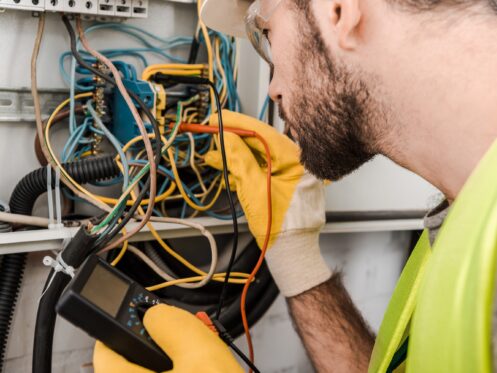Starting a new build in Florida means juggling permits, materials, and timelines, but wiring shouldn’t be an afterthought. Electrical work is bigger than most people realize, from safety to long-term efficiency. The earlier you involve the right team, the better your outcome. Top Flight Electric works with contractors and homeowners to keep buildings powered, code-compliant, and ready for the demands of Florida living.
Florida’s Climate Creates Electrical Demands
When you build in Florida, the weather isn’t just a backdrop. It plays a direct role in how your electrical system performs. High humidity, salt in the air, and frequent thunderstorms all stress wiring, panels, and outlets. If your electrical system isn’t planned with those pressures in mind, it won’t take long for problems to show up.
Heat causes materials to expand. Salt speeds up corrosion. And lightning doesn’t have to strike your house to damage your system. A close hit can send a surge through buried lines or neighborhood transformers. These aren’t rare events. They’re part of everyday life in the state. That means the electrical design for your new build needs more than just a list of fixtures. It must handle high moisture, resist corrosion, and protect your investment during power surges.
You can’t build for Florida with a one-size-fits-all plan. It takes an electrician who knows the way Florida’s conditions affect systems behind the drywall. Someone who has worked through a storm season can tell you how to avoid the common failure points and keep your system steady even when the weather isn’t.
Permits, Inspections, and Code Compliance Are Different Here
Florida has some of the country’s strictest building codes, including your electrical system. These codes don’t just cover how things look. They also investigate how wires are run, panels are protected, and outlets and circuits handle moisture. If you skip steps or try to DIY this part of your build, it won’t just slow you down; it can cost you the inspection.
Local permits require accurate drawings; your inspections will look for exact code matches. Those requirements get updated more frequently in areas with high environmental risk. What passed inspection five years ago might not cut it now. You risk delays or rework if you aren’t working with a licensed electrician who stays current with Florida-specific codes.
Building inspectors aren’t just checking for function. They’re checking for future safety. That includes GFCI protection, grounding, circuit load balancing, and arc fault protection in living spaces. Each of these needs to be installed the right way from the beginning. If your home passes inspection but cuts corners, the wiring behind your walls becomes a hidden liability. Working with a whole-house wiring expert who understands local enforcement saves you time, avoids do-overs, and keeps your schedule moving.
Proper Load Planning Makes or Breaks Your Build
Your electrical system isn’t just wires and switches. It’s a power distribution network that supports every appliance, device, and system in the home. During a new build, that network must be sized and balanced to match your lifestyle. It’s easy to under-plan for power needs when you’re focused on layout or finishes, but your load demands increase quickly once you move in.
In Florida, your air conditioning system pulls a large chunk of power. That’s not negotiable in summer. Add modern kitchen appliances, media systems, charging stations, and maybe even a pool or electric vehicle, and your panel looks smaller than you expected. Poor load planning means tripping breakers or overworked circuits right from the start.
A licensed electrician can calculate your home’s load needs based on real habits, not just square footage. That includes spacing outlets correctly, installing dedicated circuits where needed, and making room for expansion later. If you ever plan to install solar, a backup generator, or a home office setup, planning matters more than you think. Once drywall goes up, changes cost more and take longer. Smart load planning gives you room to live and grow without overloading your system.
Safety Isn’t Just About the Final Inspection
Electrical safety in new construction starts before a single wire gets pulled. It starts with the layout and material selection. In Florida, where storms and floods are a constant threat, you need a system that holds up under pressure. That means using weather-resistant boxes in the right locations, placing panels above flood levels when required, and grounding the system in ways that handle unexpected surges.
Installing the right breakers is only part of the story. A good electrician checks how wires are run, how junctions are protected, and whether nearby systems could interfere with safe function. For example, running electrical systems too close to HVAC ducts or plumbing without proper spacing can create problems later. A loose connection might pass inspection but fail under pressure from heat or moisture.
Professionals know which materials hold up best and how to protect every connection point. They also test each part of the system as they go. That gives you peace of mind when the walls close up and everything disappears behind paint and drywall. Cutting corners on safety during construction means bigger risks when systems are live and loaded.
Storm Protection Starts During the Build
Florida homes are exposed to lightning more often than homes in nearly any other part of the country. Storm protection isn’t optional; it’s part of responsible construction. But lightning doesn’t just hit roofs. It travels through buried lines, service connections, and metal conduits. That’s why you need to think about surge protection at the panel, not just at individual devices.
Whole-home surge protectors must be sized correctly and installed at the main service entrance. They protect your HVAC system, major appliances, and hardwired electronics from sudden voltage spikes. That level of protection can’t be added easily once construction wraps up; it needs to be part of the plan from the early wiring stages.
Depending on the property layout and elevation, some homes also benefit from lightning rods and additional grounding. You may need layered protection if your home sits at a high point or near tall trees. An experienced electrician can walk the site and tell you what’s smart to add now, before the ceilings close and access gets tricky.
Smart Systems Need Smarter Wiring
Today’s homes rely more on smart devices than ever before. For everything from security systems to lighting controls to thermostats and doorbells, you need low-voltage wiring and careful routing. These systems often run alongside your high-voltage power lines; if they aren’t planned properly, signal interference or power leaks can mess with performance.
You might assume your internet provider or security installer will take care of that wiring later, but by then, the drywall is up, and access is limited. That leads to wall cuts, added labor, and a patchwork feel in a brand-new space. Planning the low-voltage side with your electrician during construction avoids those issues.
This also includes structured wiring for entertainment, whole-home audio, camera feeds, and future automation. If you want flexibility later, conduit runs, access panels, and junction boxes are in the right spots. A licensed electrician will build those details into the wiring plan, even if you don’t install every component immediately.
Make Sure Your Electrical System is Set in Your New Builder Home
Florida homes face high humidity, lightning storms, and heavy power demands, so your electrical system needs to be built for more than just the basics. Starting with a professional ensures fewer headaches and more control over your new space’s functions. If you’re creating and want it done right, get Top Flight Electric on the job early.
We also offer panel upgrades, whole-home surge protection, and backup generator installations to support safe, reliable power in your new construction project.

